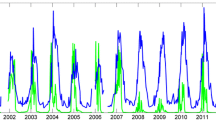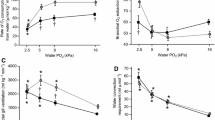Abstract
In situ respiration rates as a response to the odor of food were measured for two species of scavenging amphipods, Paralicella caperesca from 3 650 m in the western North Atlantic Ocean and Orchomene sp. B from 1 300 m in the Santa Catalina Basin off southern California (USA). In addition, complementary laboratory starvation/respiration rates for a shallow-water species, Orchomene sp. A, were determined. Initial elevated O2 consumption rates were found for up to 8 h in all deep-sea amphipods exposed to bait odor, followed by a period of lowered respiration equivalent to rates observed in individuals not exposed to bait. Orchomene sp. A revealed a response similar to that observed in the deep-sea species. A metabolic strategy is proposed whereby scavenging amphipods efficiently utilize large episodic organic falls in the food-limited environment of the deep sea. This strategy involves (1) the ability to withstand long periods of starvation, (2) rapid response to an organic fall, (3) rapid location of the organic fall, (4) maximal rate of food consumption with maximal quantity ingested, and (5) efficient utilization of the consumed food. Each of these attributes are explored with the expected and observed mechanisms employed to achieve them.
Similar content being viewed by others
Literature Cited
Ansell, A. D.: Distribution, growth and seasonal changes in biochemical composition for the bivalve Donax vittatus (da Costa) from Kames Bay, Millport. J. exp. mar. Biol. Ecol. 10, 137–150 (1972)
Ansell, A. D.: Changes in O2 consumption, heart rate and ventilation accompanying starvation in the decapod crustacean Cancer pagurus. Neth. J. Sea Res. 7, 455–475 (1973)
Bligh, E. G. and W. J. Dyer: A rapid method of total lipid extraction and purification. Can. J. Biochem. Physiol. 37, 911–917 (1959)
Bowman, T. E. and R. B. Manning: Two arctic bathyal crustaceans: the shrimp Bythocaris cryonesus new species, and the amphipod Eurythenes gryllus, with in situ photographs from Ice Island T-3. Crustaceana 1972 (23), 187–201 (1972)
Busdosh, M. and R. M. Atlas: Response of two Arctic amphipods, Gammarus zaddachi and Boeckosimus (Onisimus) affinis, to variations in temperature and salinity. J. Fish. Res. Bd Can. 32, 2564–2568 (1975)
Childress, J. J.: The respiratory rates of midwater crustaceans as a function of depth of occurrence and relation to the O2 minimum layer off southern California. Comp. Biochem. Physiol. 50A, 787–799 (1975)
Childress, J. J.: Effects of pressure, temperature and oxygen on the oxygen-consumption rate of the midwater copepod Gaussia princeps. Mar. Biol. 39, 19–24 (1977)
Childress, J. J. and M. H. Nygaard: Chemical composition and buoyancy of midwater crustaceans as function of depth of occurrence off southern California. Mar. Biol. 27, 225–238 (1974)
Covich, A.: Analyzing shapes of foraging areas: some ecological and economic theories. A. Rev. Ecol. Syst. 7, 235–258 (1976)
Crisp, M., J. Davenport and S. E. Shumway: Effects of feeding and of chemical stimulation on the O2 uptake of Nassarius reticulatus (Gastropoda: Prosobranchia). J. mar. biol. Ass. U.K. 58, 387–399 (1978)
Cummins, K. W. and J. C. Weycheck: Caloric equivalents for investigations in ecological energetics. Mitt. int. Verein. theor. angew. Limnol. 18, 1–158 (1971)
Dahl, E.: Deep-sea carrion feeding amphipods: evolutionary patterns in niche adaptation. Oikos 33, 167–175 (1979)
Dayton, P. K. and R. R. Hessler: Role of biological disturbance in maintaining diversity in the deep sea. Deep-Sea Res. 19, 199–208 (1972)
Edwards, R. R. C., D. M. Finlayson and J. H. Steele: The ecology of 0-group plaice and common dabs in Lock Ewe. II. Experimental studies in metabolism. J. exp. mar. Biol. Ecol. 3, 1–17 (1969)
Emery, K. O. and J. Hulsemann: Submarine canyons of southern California. Part I. Topography, water and sediments. Allan Hancock Pacif. Exped. 27 (1), 1–80 (1963)
Fincham, A. A.: Rhythmic swimming and rheotropism in the amphipod Marinogammarus marinus (Leach). J. exp. mar. Biol. Ecol. 8, 19–26 (1972)
Fish, J. D. and G. S. Preece: The ecophysiological complex of Bathyporeia pilosa and B. pelagica (Crustacea: Amphipoda) I. Respiration rates. Mar. Biol. 5, 22–28 (1970)
Fuzessery, Z. M. and J. J. Childress: Comparative chemosensitivity to amino acids and their role in the feeding activity of bathypelagic and littoral crustaceans. Biol. Bull. mar. biol. Lab., Woods Hole 149, 522–538 (1975)
George, R. Y.: What adaptive strategies promote immigration and speciation in deep-sea environment. Sarsia 64, 61–65 (1979a)
George, R. Y.: Behavioral and metabolic adaptations of polar and deep-sea crustaceans: a hypothesis concerning physiological basis for evolution of cold adapted crustaceans. Bull. biol. Soc. Wash. 1979 (3), 283–296 (1979b)
Halcrow, K. and C. M. Boyd: The O2 consumption and swimming activity of the amphipod Gammarus oceanicus at different temperatures. Comp. Biochem. Physiol. 23, 233–242 (1967)
Heinrich, B.: Energetics of pollination. A. Rev. Ecol. Syst. 6, 139–170 (1975)
Hessler, R. R., C. L. Ingram, A. A. Yayanos and B. R. Burnett: Scavenging amphipods from the floor of the Philippine Trench. Deep-Sea Res. 25, 1029–1047 (1978)
Hessler, R. R., J. D. Isaacs and E. L. Mills: Giant amphipod from the abyssal Pacific Ocean. Science, N. Y. 175, 636–637 (1972)
Hindley, J. P. R.: The detection, location and recognition of food by juvenile banana prawns, Penaeus merguiensis (de Man). Mar. Behav. Physiol. 3, 193–210 (1975)
Holland, D. L. and P. A. Gabbott: A micro-analytical scheme for the determination of protein, carbohydrate, lipid and RNA levels in marine invertebrate larvae. J. mar. biol. Ass. U.K. 51, 659–668 (1971)
Horridge, G. A.: Some recently discovered underwater vibration receptors in invertebrates. In: Some contemporary studies in marine science, pp 395–405. Ed. by H. Barnes. London: George Allen & Unwin Ltd. 1966
Ikeda, T.: Nutritional ecology of marine zooplankton. Mem. Fac. Fish. Hokkaido Univ. 22, 1–97 (1974)
Isaacs, J. D.: The nature of oceanic life. Scient. Am. 221, 146–162 (1969)
Jannasch, H. W., R. L. Cuhel, C. O. Wirsen and C. D. Taylor: An approach for in situ studies of deep-sea amphipods and their microbial gut flora. Deep-Sea Res. 27A, 867–872 (1980)
Jumars, P. A. and E. D. Gallagher: Deep-sea community structure: three plays on the benthic proscenium. In: The environment of the deep sea. Ed. by W. G. Ernst and J. Morin. Englewood Cliffs, New Jersey: Prentice-Hall (In press)
Kitchell, J. A.: Deep-sea foraging pathways: an analysis of randomness and resource exploitation. Paleobiology 5, 107–125 (1979)
Kleerekoper, H.: Some aspects of olfaction in fishes with special reference to orientation. Am. Zool. 7, 385–395 (1967)
Klekowski, R. Z., K. W. Opalinski and S. Rakusa-Suszcewski: Respiration of antarctic Amphipoda Paramoera walkeri Stebbing during the winter season. Polskie Archwm Hydrobiol. 20, 301–308 (1973)
Laverack, M. S.: Aspects of chemoreception in Crustacea. Comp. Biochem. Physiol. 8, 141–151 (1963)
Lee, R. F.: Lipid composition of the copepod Calanus hyperboreus from the Arctic Ocean. Changes with depth and season. Mar. Biol. 26, 313–318 (1974)
Mackintosh, J.: The effect of hunger and satiety on swimming activity in the amphipod, Marinogammarus obtusatus Dahl. Comp. Biochem. Physiol. 45A, 483–487 (1973)
Marsh, J. B. and D. B. Weinstein: Simple charring method for determination of lipids. J. Lipid Res. 7, 574–576 (1966)
Meador, J. P.: Chemoreception and food finding abilities of a lysianassid amphipod, 108 pp. MSc thesis, San Diego State University, San Diego, California 1981
Morris, R. J.: Changes in the lipid composition of Acanthephyra purpurea Milne Edwards (Crustacea: Decapoda) during its diurnal migration: a preliminary investigation. J. exp. mar Biol. Ecol. 13, 55–61 (1973)
Nahorski, S. R. and K. J. Rogers: An enzymic fluorometric micro method for determination of glycogen. Analyt. Biochem. 49, 492–497 (1972)
Opalinski, K. W.: Standard, routine and active metabolism of the Antarctic amphipod Paramoera walkeri Stebbing. Polskie Archwm Hydrobiol. 21, 423–429 (1974)
Paul, A. Z.: Trapping and recovery of living deep-sea amphipods from the Arctic Ocean floor. Deep-Sea Res. 20, 289–290 (1973)
Pearse, J. S. and A. C. Giese: The organic constitution of several benthonic invertebrates. Comp. Biochem. Physiol. 18, 47–57 (1965)
Pearson, O. P.: The metabolism of hummingbirds. Condor 52, 145–152 (1950)
Percy, J. A.: Seasonal changes in organic composition and caloric content of an Arctic marine amphipod Onisimus (=Boeckosimus) affinis H. J. Hansen. J. exp. mar. Biol. Ecol. 40, 183–192 (1979)
Pyke, G. H., H. R. Pulliam and E. L. Charnov: Optimal foraging: a selective review of theory and tests. Q. Rev. Biol. 52, 137–154 (1977)
Schoener, T. W.: Theory of feeding strategies. A. Rev. Ecol. Syst. 2, 369–404 (1971)
Schwarz, J. R., A. A. Yayanos and R. R. Colwell: Metabolic activities of the intestinal microflora of a deep-sea invertebrate. Appl. envirl Microbiol. 31, 46–48 (1976)
Shulenberger, E. and R. R. Hessler: Scavenging abyssal benthic amphipods trapped under oligotrophic central North Pacific Gyre waters. Mar. Biol. 28, 185–187 (1974)
Smith, K. L., Jr.: Benthic community respiration in the N. W. Atlantic Ocean: in situ measurements from 40–5 200 m. Mar. Biol. 47, 337–347 (1978)
Smith, K. L., Jr. and R. J. Baldwin: Deep-sea respirometry: in situ techniques. In: Handbook on polarographic O2 sensors: aquatic and physiological applications, Ed. by H. Forstner and E. Gnaiger. Berlin: Springer-Verlag (In press)
Smith, K. L., Jr. and M. B. Laver: Respiration of the bathypelagic fish Cyclothone acclinidens. Mar. Biol. 61, 261–266 (1981)
Smith, K. L., Jr., G. A. White, M. B. Laver, R. R. McConnaughey and J. P. Meador: Free vehicle capture of abyssopelagic animals. Deep-Sea Res. 26A, 57–64 (1979)
Strickland, J. D. H. and T. R. Parsons: A practical handbook of seawater analysis, 2nd ed. Bull Fish. Res. Bd. Can. 167, 1–310 (1972)
Thurston, M. H.: Scavenging abyssal amphipods from the North-East Atlantic Ocean. Mar. Biol. 51, 55–68 (1979)
Wolff, T.: Archimede Dive 7 to 4 160 metres at Madeira: observations and collecting results. Vidensk. Meddr dansk naturh. Foren. 134, 127–147 (1971)
Yayanos, A. A. and J. C. Nevenzel: Rising-particle hypothesis: rapid ascent of matter from the deep ocean. Naturwissenschaften 65, 255–256 (1978)
Author information
Authors and Affiliations
Additional information
Communicated by N. D. Holland, La Jolla
Rights and permissions
About this article
Cite this article
Smith, K.L., Baldwin, R.J. Scavenging deep-sea amphipods: Effects of food odor on oxygen consumption and a proposed metabolic strategy. Mar. Biol. 68, 287–298 (1982). https://doi.org/10.1007/BF00409595
Accepted:
Issue Date:
DOI: https://doi.org/10.1007/BF00409595




